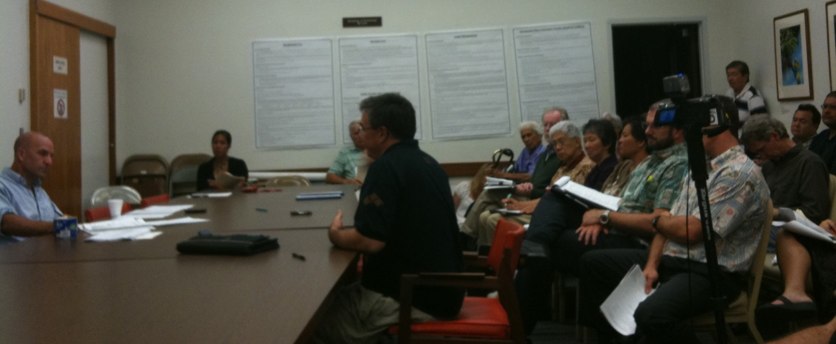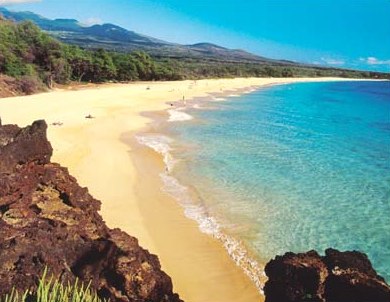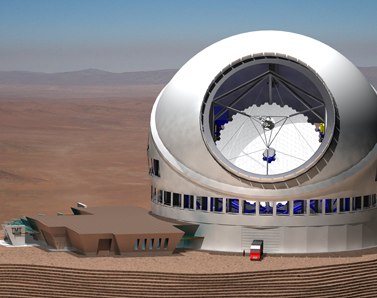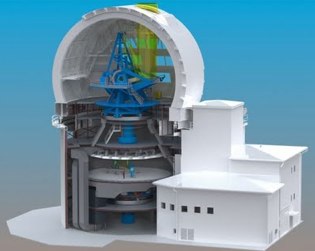Blog
News, updates, finds, stories, and tidbits from staff and community members at KAHEA. Got something to share? Email us at: kahea-alliance@hawaii.rr.com.
Laughable public process: changes to conservation protections

Hearings officer Sam Lemmo, the administrator for OCCL, made a point of assuring the room that the final regulations would definitely be different from what we are seeing tonight based on all of the great input they had been getting. (Did you just feel that gentle pat on the top of your head? I did.)
We pressed Sam on when we might actually see the final regulations. Generally speaking, the agenda for the Board of Land and Natural Resources is posted a mere six-days before the Board decides an issue. Will we only get six days to review the final version of the rules that are supposed to be protecting our conservation lands for at least the next 15 years?
In response, Sam chuckled and said “good question.” The audience laughed. I laughed, too — because what do you do when someone laughs in your face? Despite all the laughter it was a sad moment.
It is sad when regulations as important as these are given but the bare minimum of study and public process. We are talking about 2 million acres of conservation lands — our watersheds, nearshore waters… the important places. Conservation lands are 51% of the crown and government lands that are supposed to be held in the “ceded” lands trust for Native Hawaiians and the people of Hawaii — we have an obligation to protect these assets.
From what I hear from the old-timers, when these rules were changed 15 years ago, there was a public blue ribbon panel convened to advise the division on improving the regulations. Today, DLNR is unilaterally proposing major revisions. What gives? Where is the expert panel? The thoughtful study? The reasoned assessment?
In response to my quote on the need for “a blue ribbon panel” in the Star-Advertiser on Thursday, several insiders came forward at the hearing to thank Sam for DLNR’s history of work on these rule changes that were, in their words, “a long-time coming.” So long in coming, in fact, that the public just heard about them. These rules saw the first light of day in July and are expected to be approved before December. Coincidentally, that’s right before the Lingle Administration leaves office. Feels more like a 50-yard dash than a “long-time coming” to me.
Both in and out of public hearings, we have heard Sam say, at least 20 times (no exaggeration, I seriously counted), “Good question, that wasn’t what I intended” in response to questions and concerns about the staff’s proposed changes. I don’t know about you guys, but if what I write down isn’t what I meant to say, its usually because I was in a rush and didn’t take the time to think about the implications… welll… that kind of pondering is exactly what we need right now.
Good changes, bad changes, the bottom line is these changes need more thought. We should not let the timeline for the end of an administration drive the schedule for amending some of the most important protections in our islands.
Want to feel like you were there? Here is a link to notes from the Honolulu public hearing on August 12, 2010.
Want to participate in the process? Sign up for KAHEA’s action alert network, later this week we’ll send out an easy-to-use comment form by email.
Collaborate Much?

We’re liking this thought-proving post from journalist Anne Minard, on the “next great telescope race”–Day 14 of her “100 Days of Science.” She asks some great questions about the fundamental purpose of the two U.S. proposals for “next generation” giant land-based telescopes being proposed for construction within the next 10 years. Do we really need THIS much telescope, guys?
Charles Alcock, director of the Harvard-Smithsonian Center for Astrophysics, acknowledged that the two telescopes are headed toward redundancy. The main differences, he said, are in the engineering.
He said the next generation of telescopes is crucial for forward progress in 21st Century astronomy.
“The goal is to start discovering and characterizing planets that might harbor life,” he said. “It’s very clear that we’re going to need the next generation of telescopes to do that.”
And far from being a competition, the real race is to contribute to science, said Charles Blue, a TMT spokesman.
“All next generation observatories would really like to be up and running as soon as possible to meet the scientific demand,” he said.
But when I asked him why the United States teams haven’t pooled their expertise to build a single next-generation telescope, Blue declined to comment.
In all, there are actually three teams (two from the U.S., and one from Europe) racing to build the first of these giant land-based telescopes: Extremely Large Telescope (Europe), TMT (U.S.), and Giant Magellan Telescope (U.S.). (And no, we’re not making these names up… in almost every description we could find, these bad boys are characterized first and foremost by their massive size.) The total estimated price tag for all this summit development? $2.6 billion dollars.
In the midst of this competition to build the first and the largest, the worldwide community of those who share aloha for sacred summits are humbly asking: for time and real consideration for native ecosystems, threatened endemic species, the cultural meaning of sacred space, cultural practice, and the natural and cultural heritage we have to pass forward to next generations… all in short supply on earth today. Can we not rationally slow down this latest race for space, in the interest of the future of life on our own planet?
Exemptions Gone Wild
Generally, under today’s environmental laws, certain kinds of projects have to do an environmental review (Like an EIS). Other kinds of projects can be exempted. The BP oil spill at Deepwater Horizon has been a sobering reminder of why these kinds of environmental reviews and exemptions are so critical. (Can you believe THIS was exempted from EIS?)

Today, DLNR is proposing a “wild laundry list” of EIS exemptions for DLNR-managed lands, from building new roads to chemical herbicides. That’s 57 pages (fifty-seven!) of exemptions. Yeesh. We are asking the Office of Environmental Quality and Control (OEQC) to send DLNR back to the drawing board. If you or your organization is interested in participating in a group letter to OEQC or just want to know more about this issue, please contact Marti at marti@kahea.org by Friday morning.

Manufacturing Consent

The UH Board of Regents made big “TAH-DAH!” over approving their giant Thirty Meter Telescope project for Mauna Kea this summer. Plenty press releases, plenty press. KAHEA staff tend to kind of shrug over this kind of “approval”, but after hearing so many comments and questions from all of you, we decided we should address it. Fundamental question: WHY is the Board of Regents approving TMT?
The term “manufacturing consent” comes to mind. Hmm.
Okay, let’s say for example, that Kanoe and Tyler want to build a parking lot in your front yard. Kanoe writes the proposal. Tyler votes to approve her proposal, and sends out a press release saying “Parking lot approved!” And your neighbors think, “”My, my. There’s going to be a parking lot over there.” Now, did you get any say about this parking lot? Nope! Does it matter? Of course it does.
A little tutorial on developing conservation lands, and looking good while doing it:
Mauna Kea is public trust “ceded lands” and a conservation district. This means that the mountain is to be managed “in trust” for the people of Hawai’i, and that its natural and cultural resources are to be protected and sustained. Under state law, the responsibility for managing these lands falls to the Department of Land and Natural Resources (DLNR). DLNR does not financially benefit directly from development of Mauna Kea, and it is the agency with the mandate under state law to protect and conserve these lands.
Yet.
Today, the University Board of Regents appoints 100% of members to the Office of Mauna Kea Management. The Regents appoint 100% of the members of Kahu Ku Mauna. The University paid the consultant who wrote the management plan for Mauna Kea. At the end of the day, we have to ask: Who’s interests are being represented? Who is being left out?
So many have worked so hard and sacrificed so much, to get us to where we are today. Twenty years ago, the University and the UH Institute for Astronomy could not and would not even acknowledge the existence of clear problems. Two lawsuits and two state audits later, we can finally openly acknowledge past wrongs, and talk about impacts of astronomy development on cultural and natural resources. Not just on Mauna Kea, but Hawai’i's other sacred summits as well.
But without true change in management (!), it’s just that: talk.
If you support true community management of Hawai’i's sacred summits, you can join with the thousands of others around Hawai’i who are saying “Enough already” and demand a truly pono future for some of Hawai’i's most sacred places. Sign the petition today!
Action Alert: Haleakala Solar Telescope

On August 26, the BLNR will hear public testimony on the 14-story telescope proposed for Haleakala. We really need community members to show up early, sign up to speak, and give testimony on this giant telescope proposal. You can read the flyer here.
From Kilakila Haleakala:
All studies done for the proposed project indicate that in addition to the misuse of conservation lands, there will be major, adverse, short- and long-term direct impacts on traditional and cultural resources. We must let them know know that our summit will not be furuther desecrated.
You can read more at http://www.kilakilahaleakala.org
Wanting another perspective? We’re also liking this thoughtful take on the Haleakala proposal by blogger and astronomer Salman Hameed.
HaleakalaAHHHHH! WASSSPS!
From Melissa:
Haleakala National Park is being invaded by Yellowjacket wasps as you are reading this blog.
Invading wasps in Haleakala National Park, which usually make nests the size of a football, have grown nests “the size of a ’57 Buick,” according to a new study.
Research just published in the Proceedings of the National Academy of Sciences shows a fascinating interplay in which the invaders are being shaped by their new environment, just as they are drastically changing the native ecosystem. Not only do the aliens — western yellowjacket wasps, Vespula pensylvanica — take advantage of the lack of cold winters to grow huge nests, they have taken to eating vertebrate meat as well as other insects, geckos and native shearwaters.
Erin Wilson, who has just completed a doctorate in biology at the University of California, San Diego, studied the yellowjackets at Haleakala and Hawaii Volcanoes national parks in 2006 and 2007. The yellowjackets have been a problem in the parks for years, but their new diet and their numbers were a surprise.
In a telephone interview from Acadia National Park in Maine, where she is vacationing, Wilson said yellowjackets like high, lonely places.
They are hard to find, which is why the size of the nests — up to 600,000 individuals compared with a few thousand in a usual nest — escaped attention.
Along with Argentinian ants, the yellowjackets are among the most dangerous alien arthropod invaders of the park.
“It’s not just what they’re killing,” Wilson said. “They’re also collecting great amounts of nectar, drawing down the resources for anything else that might want to feed on it, whether it’s native insects or birds like the Hawaiian honeycreepers.”
The wasps do not attack and kill vertebrates. They scavenge the protein-rich remains of dead animals. But even that could help unbalance the native ecosystem by usurping the food supply for native scavengers, like the pueo.
To read full story, click here
Arguments supporting telescope are fallacies
From Alana:
The following letter to the editor, published in The Maui News newspaper, plainly shows that the logic UH uses to defend its proposed telescope is very flawed.
A fallacious argument is made that because Hawaiians revered astronomy, then anything done in the 21st century with respect to astronomy is automatically consistent with Hawaiian spirituality. It’s like saying because Hawaiians revere kalo and because a company wants to genetically modify kalo they’re actually not at cross purposes – they both have proper respect for kalo, they’re just looking at it differently. That logic is unacceptable!
It is also unacceptable logic that infers that during the 19th century period of Hawaiian monarchy, Kalakaua introduced telescopes to Hawaii and he would be – and we should be – in favor of the ATST. Well, Kalakaua also introduced electricity to Hawaii. Shouldn’t we, by the same logic, light up Maui – or at least the top of Haleakala – at night with electric lights? Of course not!
For Kiope Raymond’s entire analysis click here.






